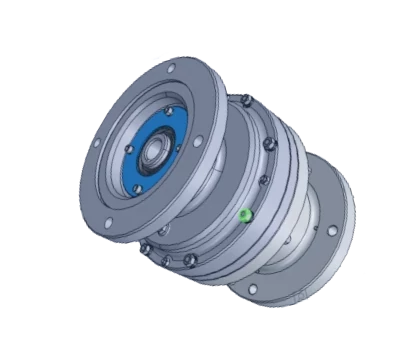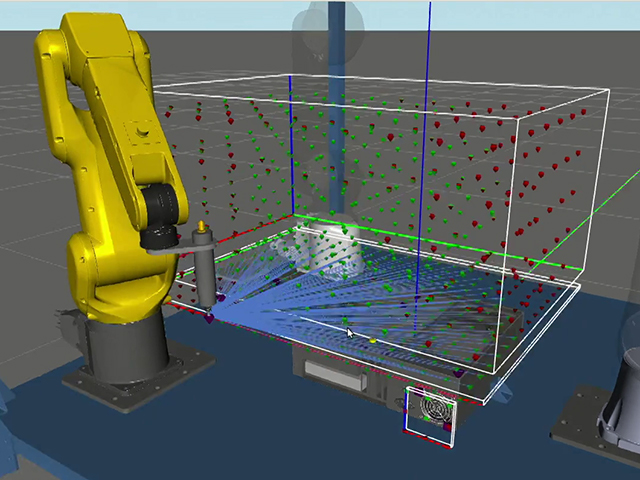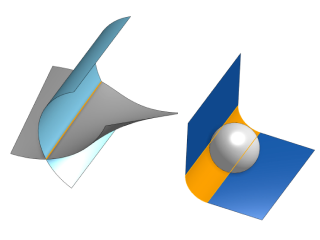

How to convert Parasolid
to JT?
Applications for end-users. SDK's and tools for software developers. Custom development services for businesses.
Trusted by industry leaders







Available in CAD Exchanger Products
 CAD Exchanger Lab
CAD Exchanger Lab
Desktop app to view, explore and convert 3D CAD data across 30+ file formats
Learn more

Parasolid
Parasolid file format is native for Parasolid geometrical kernel, a widely used 3D geometric modeling kernel developed by Siemens PLM Software. This kernel provides a set of advanced tools and algorithms for creating, editing, and analyzing complex models. Like any kernel, Parasolid also has a persistence format known as Parasolid-XT. The Parasolid format refers to the file format used to store and exchange 3D geometry data created using Parasolid.
Support of Parasolid files in CAD Exchanger
CAD Exchanger can import files starting from v0.15 and up to v35 and export files from v12 to v35. Such support includes:
- B-Rep representations;
- assembly structure;
- names;
- user-defined properties;
- colors;
- layers.
Follow this link to check out all the CAD Exchanger products.
Pros of the format
Kernel nature
The primary advantage of Parasolid-XT lies in its kernel-based architecture. When you need to import data into CAD software running on the Parasolid kernel, opting for this format is a wise decision. As a kernel format, Parasolid-XT excels in its handling of B-Rep geometry, demonstrating exceptional proficiency in storing intricate B-Rep models encompassing solids, sheets, wireframes, mixed components, and even non-manifold topologies.
A notable advantage over the ACIS-SAT format is its capacity to represent the model hierarchy, albeit with some limitations (parts and bodies are somewhat synonymous). Nevertheless, in essence, the conversion to Parasolid-XT has the potential to preserve your part-assembly hierarchies, adding to its appeal as a preferred choice.
Representation of hybrid models
Another notable capability is the endorsement of hybrid models, specifically those in which a single logical component encompasses both B-Rep and mesh geometry. While this scenario currently represents a relatively small portion of real-world data exchange, it's gaining popularity. Consequently, the Parasolid kernel has been actively advancing to embrace these models, with the most recent iterations of the Parasolid-XT format designed to handle them.
Cons of the format
Proprietary nature
Parasolid is a proprietary format owned and developed by Siemens PLM Software. This means that the specifications of the format are not publicly available, and only licensed software developers can fully access and utilize the features of Parasolid. While many CAD software applications support the import and export of Parasolid files, the lack of public specifications can limit the ability to develop custom tools or work with the format outside of the licensed software ecosystem.
The lack of extensive metadata and visual attributes support
Parasolid-XT offers some support for metadata and visual attributes, including the ability to name entities, assign colors to shapes, utilize layers, and user-defined properties as key-value pairs. However, if you're dealing with multi-body parts, PMI, or advanced metadata, it might be more beneficial to consider using alternative formats like STEP or JT. These formats provide more extensive support for those specific requirements.
FAQ
What are the benefits of using Parasolid format?
The Parasolid format offers exceptional interoperability, and precise B-rep modeling ensures high geometric accuracy, making it suitable for complex engineering and design tasks. Its wide industry adoption makes it a trusted and standardized format, ensuring compatibility and long-term support.
Which industries use Parasolid format?
The Parasolid format finds extensive use in various industries due to its versatility and precision. Industries such as aerospace, automotive, manufacturing, consumer electronics, and medical devices all rely on Parasolid for 3D modeling and design. Its broad adoption across these sectors facilitates the development of everything from aircraft components and automotive designs to medical implants.
What are the primary Parasolid file extensions?
In Parasolid, two primary file extensions are commonly used. The first one is .x_t (Parasolid Text), which represents a text-based format. It stores 3D geometric data in a text format, allowing for easy interoperability between different CAD systems. The second extension is .x_b (Parasolid Binary), which represents a binary format. .x_b files contain the same geometric information as .x_t files but in a more compact and faster-to-process binary format.
History of Parasolid format
The Parasolid format, as a file format for storing 3D geometry, has its own history. Developed by Shape Data Limited in the 1980s, the Parasolid format was designed to enable the exchange of 3D solid models between different CAD systems.
In 1996, the company was acquired by Unigraphics Solutions Inc., which eventually became part of Siemens PLM Software. Since then, Parasolid has continued to evolve and adapt, keeping up with the ever-changing demands of the CAD industry.
With its powerful capabilities and efficient representation of 3D geometry, Parasolid quickly became a standard format for CAD software developers. Its widespread acceptance can be attributed to its seamless interoperability. Many leading CAD software applications, including Siemens NX, Solid Edge, and SolidWorks, incorporate Parasolid as their underlying kernel, allowing users to create, modify, and exchange complex 3D models with ease.
Over the years, Parasolid has played a vital role in various industries, such as automotive, aerospace, and consumer goods. Its precision and accuracy have made it an indispensable tool for designers and engineers, enabling them to tackle intricate designs and perform detailed analyses. Today, Parasolid remains a cornerstone in the CAD landscape, empowering professionals to bring their creative ideas to life in the virtual world.
JT
The JT format is a widely used lightweight 3D data format designed for efficient visualization, collaboration, and sharing of complex 3D models and assemblies. JT files retain the fidelity of the original 3D models while minimizing file size, enabling fast loading and efficient data transmission. The format supports features like precise geometry, polygonal meshes, product structure, PMI, and animations.
Support of JT in CAD Exchanger
CAD Exchanger can import files compliant with the JT formats from 8.0 to 10.9 and ISO14306:2012 and export files compliant with the JT formats 9.5 and ISO14306:2012. Such support includes:
- B-Rep representations;
- polygonal representations (incl. multi-LODs);
- assembly structure, including via external files;
- names;
- user-defined and validation properties;
- PMI;
- colors, materials, textures;
- layers.
Follow this link to check out all the CAD Exchanger products.
Pros of the format
Advanced compression and economical data representations
Advanced compression and economical data representations
The file format employs advanced compression techniques to reduce file sizes without compromising the quality of the content. This enables efficient transmission and storage of 3D models and other visual data.
In addition to compression, JT excels in economical data representations. The format is structured in such a way that it is relatively easy to read in a selective manner. Files typically have smaller file sizes than STEP files with comparable geometry. This is achieved by efficiently representing mesh data through topological compression algorithms, which take advantage of the connectedness between mesh patches. Despite the economical representation, JT files maintain their integrity and provide a comprehensive visualization of the original content.
Great meshes support
The format is designed to handle complex 3D mesh data efficiently, making it ideal for applications that require high-quality mesh representation. JT allows for the precise encoding of mesh data, including vertex positions, normals, texture coordinates, and more. It supports both triangular and polygonal meshes, enabling the representation of intricate geometric shapes with smooth surfaces.
Moreover, JT provides robust support for mesh attributes and properties. This means that additional information, such as material properties, colors, and transparency, can be associated with individual mesh elements or the entire mesh.
Cons of the format
Proprietary legacy
While the ISO standardization brought greater openness and interoperability to this format, the legacy of its proprietary history can still be observed in certain cases. It's worth noting that the specifications for JT 7.x and earlier versions were not publicly accessible, and the format was essentially proprietary, so there were difficulties in reading and writing this format in other CAD software. Fortunately, these versions of files are not used much these days.
Implementing full-fledged JT support can be a demanding task. It requires a deep understanding of the intricacies of the format's specifications and algorithms. This can be a barrier for smaller software developers or independent implementers who may not have the resources or expertise to fully grasp and implement the complexities of the format. As a result, the quality of JT support can vary significantly.
Another consequence of the proprietary nature of the JT format is its lack of openness. The latest JT precise geometry representation is based upon the Siemens PARASOLID, which means a high-quality implementation of the format must also be able to read and write this format.
FAQ
Is JT format specification publicly available?
Yes, it is. The JT Open Program, an industry consortium dedicated to promoting the widespread use of JT as a 3D data format, provides the JT file format specification to the public. It offers various resources, including technical documentation, whitepapers, and specifications related to the JT format. These resources can be accessed on the official JT Open Program website.
What are JT file extensions?
The JT format typically uses the file extension ".jt" to denote JT files. It is worth noting that alternative file extensions may also be used in certain cases, depending on the software or system. However, ".jt" remains the most commonly used and recognized extension for JT files across different platforms and applications.
How to open a JT file?
To open this file, you will need a compatible software application, for example, CAD Exchanger Lab. Launch the software and navigate to the 'New file' option. Browse your computer's directories and locate the .jt file you want to open. Then select it and click "Open". Once the import process is complete, the .obj file should be loaded into the software, allowing you to view and interact with the 3D model and associated data.
History of JT format
The JT format, also known as Jupiter Tessellation, has a long history that traces its origins back to the 1990s. It was developed by Engineering Animation Inc., a company specializing in computer graphics and visualization software. EAI created the JT format as a lightweight and versatile solution for visualizing and sharing 3D data in industries such as manufacturing and engineering.
In 2001, EAI was acquired by UGS Corporation, which later became Siemens Digital Industries Software. Siemens recognized the potential of the JT format and continued its development, expanding its capabilities and promoting its adoption in various industries. Over the years, Siemens has worked to enhance the format, improve its compression techniques, and ensure compatibility with a wide range of software applications.
The JT format gained further recognition and acceptance when it was standardized by the International Organization for Standardization in 2012 as ISO 14306. This ISO standardization solidified the JT format's position as a reliable and widely supported file format for 3D visualization and data exchange. Today, the JT format continues to evolve and is utilized by numerous companies and industries worldwide for effective collaboration, efficient data sharing, and immersive 3D visualization.
Convert Parasolid
to JT
Need to work with CAD files in numerous formats? No worries.
From Parasolid to JT, CAD Exchanger gets you covered.
What Our Delighted Customers Say
From Our Blog

Everything you need to know about CAD file formats
A CAD file is an output of a CAD software, containing key information about the designed object: its geometry and topology representation, 3D model hierarchy, metadata, and visual attributes depending on the format of the file.
Read more
Realtime Robotics enhances responsive workcell monitoring by reading CAD files with CAD Exchanger
CAD Exchanger enables RapidSense and RapidPlan to read 3D CAD formats thanks to a unified API, fast data processing, adjustable meshing, and cancellation support.
Read more
3D formats overview: Parasolid
In the fourth part of the series, we tackle another important kernel format of the biggest geometric kernel in the business
Read more